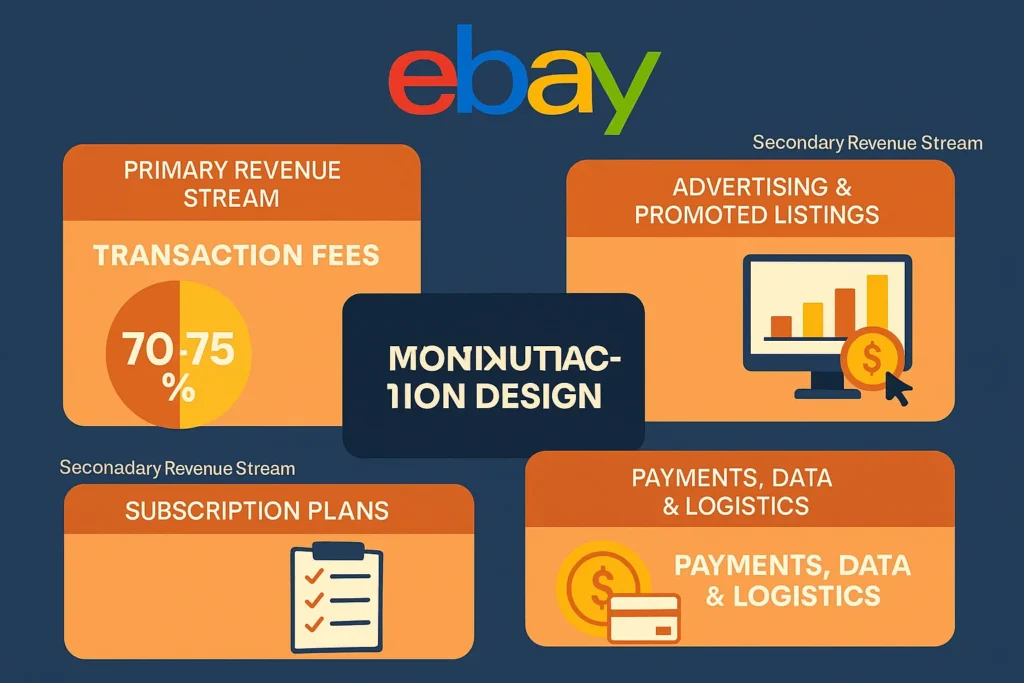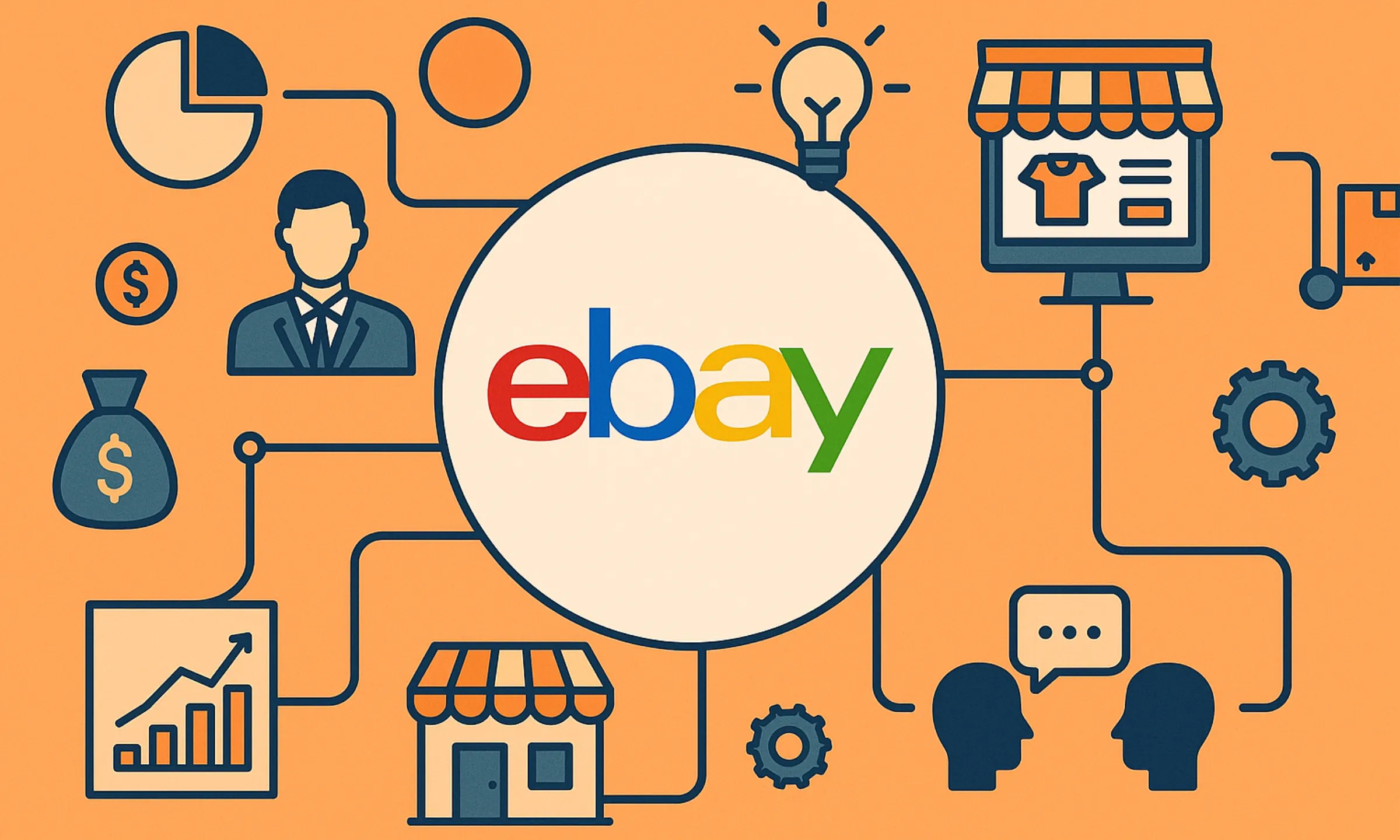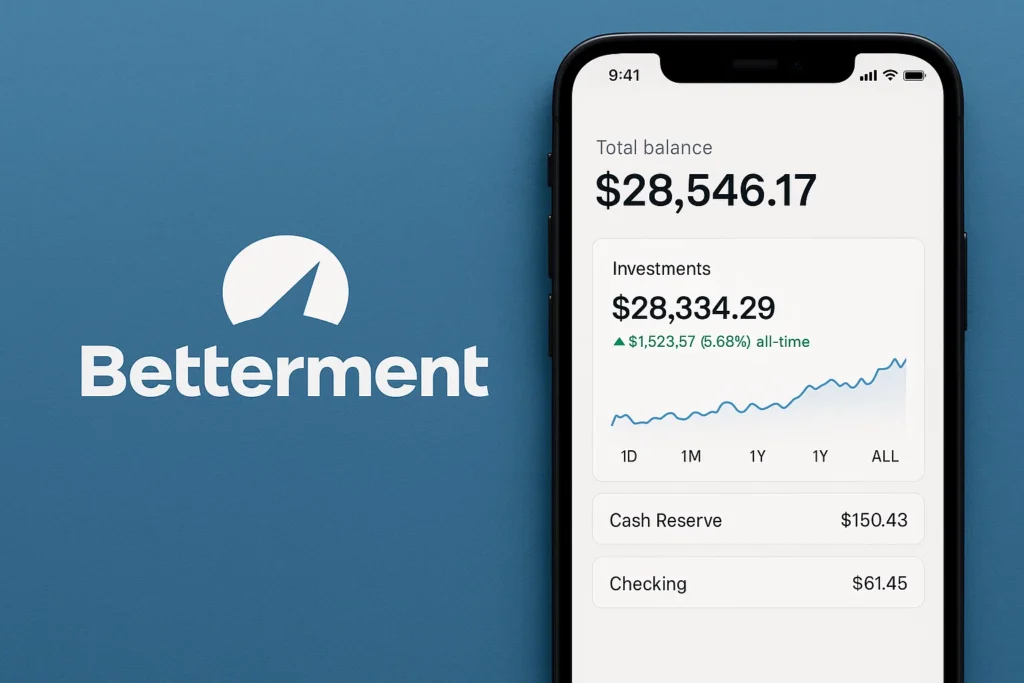From a single auction listing in 1995 to handling $75+ billion in gross merchandise volume (GMV) in 2025, the Business Model of eBay has redefined global e-commerce by proving that marketplaces thrive when trust, community, and value intersect.
Unlike vertically integrated giants like Amazon, eBay built its empire around facilitating trade rather than owning inventory — a model that inspired dozens of modern marketplace startups. Its journey offers priceless lessons for founders aiming to create scalable, low-inventory digital ecosystems — from C2C resale apps to global B2B marketplaces.
In 2025, as sustainability and circular commerce gain traction, the Business Model of eBay feels more relevant than ever. Entrepreneurs exploring white-label marketplace apps can study how eBay combines liquidity, trust, and simplicity — three elements that define a successful platform business.
How the eBay Business Model Works
eBay business model is a hybrid marketplace framework built around connecting buyers and sellers in an open ecosystem where the platform earns revenue from transaction-based fees, ads, and value-added services. It thrives by reducing ownership risk — eBay doesn’t manage inventory or logistics directly — and by building trust-based infrastructure that enables millions of users to transact globally.
1. Type of Model
- C2C & B2C Hybrid Marketplace — enabling both peer-to-peer (consumer-to-consumer) resales and professional (business-to-consumer) listings.
- Revenue Driver: Commission on completed sales, listing fees, and promoted listings.
- Core Engine: Matching buyers and sellers efficiently via algorithms and reputation systems.
2. Value Proposition
- For Buyers: Access to millions of unique, second-hand, or rare products at competitive prices with transparent seller ratings.
- For Sellers: Instant access to a global audience, flexible pricing (auction or fixed), low setup costs, and tools for marketing and analytics.
- For eBay (Platform): Recurring revenue from fees, ads, and partnerships — without inventory or manufacturing costs.
3. Stakeholders
- Buyers: Seek affordability, choice, and authenticity.
- Sellers: Range from individuals selling collectibles to SMBs managing full storefronts.
- eBay Platform: Facilitates transactions, manages trust (via payment protection and feedback systems), and handles dispute resolution.
- Partners: Payment processors (PayPal until 2020, now eBay Managed Payments), logistics providers, and marketing affiliates.
4. Evolution of the Model
- 1995–2005: Auction-based C2C dominance.
- 2006–2015: Expansion into fixed-price listings, B2C sellers, and PayPal integration.
- 2016–2020: Mobile-first optimization and focus on verified products (eBay Authenticity Guarantee).
- 2021–2025: Sustainability and recommerce push — “pre-loved” and refurbished goods marketplaces, plus integration with AI-based pricing and authenticity checks.
5. Why It Works Today (2025 Context)
- Sustainability-driven consumers prefer recommerce platforms over fast retail.
- AI pricing tools improve buyer confidence and seller margins.
- Flexible transaction models (auction + instant buy) cater to all price-sensitive demographics.
- Global reach with minimal overhead makes it highly resilient compared to inventory-heavy retailers.
Read more : What is eBay App and How Does It Work?
Target Market & Customer Segmentation Strategy
eBay’s customer base spans continents, cultures, and income levels — yet its success lies in micro-segmentation: catering to distinct user behaviors while keeping the platform universal. As of 2025, eBay serves over 130 million active buyers and 17 million active sellers, across more than 190 markets.
1. Primary Customer Segments
- Individual Sellers (C2C):
Everyday users selling used items, collectibles, or household goods.
- Motivation: Earn extra income or declutter.
- Behavior: Occasional sellers using mobile listings.
- Small Businesses (SMBs/B2C):
Independent merchants or e-commerce startups using eBay as a global storefront.
- Motivation: Access international buyers and build brand presence.
- Behavior: Frequent listings, bulk uploads, and use of paid promotions.
- Buyers (Global Shoppers):
Bargain seekers, collectors, and eco-conscious shoppers.
- Motivation: Lower prices, unique products, sustainability value.
- Behavior: High engagement during deal seasons and collectible releases.
2. Secondary Segments
- Enterprise Resellers: Liquidation firms, distributors, and refurbished goods dealers leveraging eBay’s scale.
- Collectors & Hobbyists: Passion-driven buyers trading rare items — from sneakers to NFTs and trading cards.
- Eco-conscious Consumers: Sustainability-focused buyers preferring pre-owned or refurbished goods.
3. Customer Journey
| Stage | Buyer Journey | Seller Journey |
| Discovery | Finds product via SEO, ads, or category recommendations. | Discovers eBay via tutorials, community forums, or ads. |
| Conversion | Bids or uses “Buy It Now”; pays via eBay Managed Payments. | Lists item with photos, selects auction/fixed price, and sets terms. |
| Engagement | Leaves reviews, tracks deliveries, and explores related categories. | Responds to inquiries, manages inventory, leverages “Promoted Listings.” |
| Retention | Personalized recommendations, loyalty offers. | Subscription tools (eBay Store), analytics dashboards. |
4. Market Positioning & Brand Edge
- Positioning Statement: “The trusted global marketplace for unique value — connecting passion with purpose.”
- Competitive Advantage: Longevity, brand trust, verified sellers, and a sustainable product ecosystem.
- 2025 Differentiation Strategy:
- Focus on authenticity (luxury goods, sneakers, watches).
- Push for recommerce and green economy.
- AI-driven personalization for search and pricing optimization.
Revenue Streams and Monetization Design
eBay’s monetization framework in 2025 is a multi-channel, transaction-first model — leveraging fees, advertising, and value-added services to create stable, recurring income without inventory risk. The platform earns by facilitating commerce, not by owning it — a model that maximizes scalability and minimizes operational overhead.
1. Primary Revenue Stream – Transaction Fees (~70–75% of total revenue)
Mechanism:
eBay takes a percentage-based fee from each completed sale. The rate varies by category, region, and seller type.
Pricing Model (2025):
- Standard Commission: 10–14% of the final sale price (including shipping).
- Store Subscribers: Tiered discounts for high-volume sellers.
- Additional Fees: Fixed listing insertion fees (~$0.35 per listing) for non-subscribers.
Growth Trajectory:
Steady 8–10% annual growth, supported by increased high-value product categories (luxury watches, refurbished tech, sneakers)
2. Secondary Revenue Stream 1 – Advertising & Promoted Listings (~15–18%)
Mechanism:
Sellers pay to boost product visibility via eBay’s “Promoted Listings Advanced” — a CPC-based ad system integrated into search results.
Model:
- Cost-per-click (CPC) auction model, starting from $0.02/click.
- Dynamic AI bidding based on conversion probability.
- New “AI Optimization Suite” introduced in 2024 for automated ad spend efficiency.
3. Secondary Revenue Stream 2 – Subscription Plans (~5–7%)
Mechanism:
Professional sellers and SMBs subscribe to eBay Stores, gaining analytics, branding tools, and reduced fees.
Plans (2025):
- Starter Plan: $4.95/month — basic features for casual sellers.
- Premium Plan: $21.95/month — advanced analytics, discounts, bulk listings.
- Anchor Plan: $299.95/month — enterprise-grade tools, marketing credits, API integrations.
4. Secondary Revenue Stream 3 – Payments, Data & Logistics (~5%)
Mechanism:
- Managed Payments: eBay’s in-house payment system processes transactions directly, earning a 2.7–3.2% service fee.
- Data & API Access: Monetized via business intelligence integrations.
- Logistics Partnerships: eBay partners with regional couriers, taking small referral margins per shipment.
5. Overall Monetization Strategy
eBay’s strategy is circular and scalable: the more transactions occur, the more ads sellers buy, the more subscriptions upgrade — creating a self-reinforcing revenue loop.
This structure aligns incentives — sellers earn more visibility, buyers get better recommendations, and eBay captures incremental revenue without overextending operations.

Operational Model & Key Activities
eBay’s operational framework is built around platform efficiency, trust assurance, and technology-driven scalability. Its success lies in orchestrating millions of daily transactions while maintaining quality, compliance, and user satisfaction — all without handling inventory or logistics directly.
1. Core Operations
- Platform Management:
Continuous platform monitoring to ensure uptime, scalability, and seamless transactions across 190+ markets. - Trust & Safety Systems:
AI-powered fraud detection, identity verification, and the Authenticity Guarantee Program — ensuring genuine products in categories like sneakers, watches, and handbags. - Payment Infrastructure:
Managed Payments (post-PayPal era) streamlines checkout, offering localized methods (credit, debit, BNPL, crypto). - Customer Support:
24/7 multilingual support, dispute resolution, and seller training resources. - Marketing & Community Building:
SEO-driven marketplace growth, affiliate partnerships, and community-led selling programs.
2. Key Activities
- Technology Development:
- AI-based recommendation engines and dynamic pricing models.
- Machine learning for fraud prevention and sentiment analysis.
- Advanced analytics for user behavior and predictive inventory trends.
- User Engagement Programs:
Loyalty and referral initiatives encouraging repeat buying and selling. - Recommerce and Sustainability Operations:
Partnering with certified refurbishers and recyclers to promote “pre-loved” and refurbished goods categories. - Compliance and Data Governance:
Adherence to GDPR, CCPA, and emerging AI Act requirements in 2025 for ethical data use.
3. Resource Allocation (2025 Snapshot)
| Category | Approx. Budget Allocation | Focus Area |
| Technology & Infrastructure | 45% | AI tools, cloud scalability, API systems |
| Marketing & Brand Growth | 25% | Global campaigns, influencer collaborations |
| Customer Support & Trust | 15% | Safety, dispute resolution, community programs |
| R&D & Innovation | 10% | Sustainability tech, blockchain verification |
| Administration & HR | 5% | Global hiring, culture, and policy compliance |
Strategic Partnerships & Ecosystem Development
eBay’s ecosystem thrives on a partnership-driven model — one that amplifies its marketplace capabilities through trusted alliances rather than direct ownership. Over the years, these partnerships have evolved from simple payment integrations to a robust ecosystem of technology, logistics, and sustainability partners powering its recommerce vision.
1. Partnership Philosophy
eBay believes in platform enablement through collaboration — instead of vertical integration like Amazon, it creates opportunities for third-party service providers to participate in the ecosystem. Every partnership enhances user experience, trust, or operational efficiency.
2. Key Partnership Types
- Technology & API Partners:
Collaborations with AI, data, and security providers enhance automation and personalization.
- Example: Microsoft Azure (cloud infrastructure), Adobe (marketing analytics), and third-party AI vendors for price forecasting.
- Example: Microsoft Azure (cloud infrastructure), Adobe (marketing analytics), and third-party AI vendors for price forecasting.
- Payment Alliances:
Transitioned from PayPal (until 2020) to a fully in-house Managed Payments system, while maintaining integrations with local payment processors (like Adyen in Europe, Paytm in India).
- Ensures localized compliance, currency support, and faster settlements.
- Ensures localized compliance, currency support, and faster settlements.
- Logistics & Fulfillment Partnerships:
eBay’s “Global Shipping Program” partners with DHL, FedEx, and regional logistics firms — enabling affordable international delivery.
- Sellers ship domestically, and eBay handles cross-border logistics via partner hubs.
- Sellers ship domestically, and eBay handles cross-border logistics via partner hubs.
- Marketing & Distribution Partners:
Collaborations with Google Shopping, Facebook Ads, and affiliate networks extend product reach and SEO dominance.
- 2024 marked the integration of TikTok Shopping ads for youth-focused categories.
- 2024 marked the integration of TikTok Shopping ads for youth-focused categories.
- Regulatory & Sustainability Partners:
Partnerships with organizations like WRAP and Circular Economy Initiative position eBay as a sustainability leader in recommerce — supporting certified refurbished goods and carbon-neutral shipping options.
3. Ecosystem Strategy Insight
eBay’s partnership approach builds network effects — every new partner adds value to all participants. By acting as a platform layer, eBay benefits from indirect monetization through improved transaction volume, reduced operational cost, and higher brand trust.
Read more : Best eBay Clone Scripts in 2025: Features & Pricing Compared
Growth Strategy & Scaling Mechanisms
eBay’s sustained relevance in 2025 is a product of strategic evolution, not reinvention. While competitors like Amazon or Alibaba expanded through vertical integration, eBay focused on horizontal scaling — refining its marketplace, expanding categories, and building trust around sustainability and recommerce.
1. Growth Engines
- Organic Virality & Community Loops:
eBay’s built-in social commerce mechanics (bidding wars, wishlists, and reviews) naturally drive engagement and word-of-mouth growth.
- Every listing interaction strengthens SEO presence.
- Feedback ratings act as social proof loops — essential for C2C trust.
- Paid Marketing & Retargeting:
Heavy investment in performance marketing on Google, Facebook, and TikTok for personalized re-engagement.
- 2025 ROI-driven campaigns target Gen Z resellers and collectors.
- eBay Ads API allows sellers to run integrated ad campaigns seamlessly.
- New Product Lines & Innovation:
- eBay Refurbished: Verified pre-owned electronics with warranties.
- eBay Luxury Vault: High-value goods (sneakers, watches, handbags) stored securely until sold.
- eBay Guaranteed Fit: Automotive parts program ensuring compatibility via AI model recognition.
- Geographic Expansion Models:
- Localization-first approach — adapting categories and payment gateways per region.
- Growth hotspots: India, Southeast Asia, and Eastern Europe (where recommerce trends surge).
- Partnerships with local logistics firms to overcome customs and delivery challenges.
2. Scaling Challenges & Solutions
| Challenge | Description | Solution Implemented |
| Market Saturation | Competition from Amazon, Etsy, and niche recommerce apps. | Shifted focus to authenticity, sustainability, and collectible markets. |
| Trust Gaps in Emerging Markets | Limited buyer protection and seller fraud. | Introduced eBay Protection Plus and Authenticity Guarantee. |
| Mobile Experience Gap | Rising mobile-first users needed faster UX. | Full mobile redesign with progressive web app (PWA) in 2024. |
| Cross-Border Logistics | Customs and delivery costs slowed international trade. | Expanded Global Shipping Program with regional fulfillment partners. |
3. Scaling Formula Summary
- Expand horizontally (new categories, regions, sellers).
- Automate vertically (AI pricing, authentication, logistics).
- Retain loyalty (trust, speed, and verified commerce).
This mix of ecosystem adaptability + tech scalability keeps eBay profitable in a fiercely competitive environment — proving that decentralized marketplaces can thrive even against full-stack giants.
Read more : Reasons startup choose our Ebay clone over custom development
Competitive Strategy & Market Defense
eBay’s enduring dominance in 2025 rests on a resilient competitive framework that blends brand legacy, network effects, and a data-driven evolution of trust. Unlike Amazon’s ownership-heavy model or niche vertical players like Depop and Poshmark, eBay positions itself as the open marketplace for everyone — where value meets variety.
1. Competitive Advantages
- Network Effects & Scale:
With over 130 million buyers and 17 million sellers, eBay benefits from a classic marketplace flywheel — more sellers attract more buyers, leading to greater liquidity and better price discovery. - Brand Equity & Trust:
Decades of user feedback, verified ratings, and buyer protection policies give eBay a credibility moat. The Authenticity Guarantee and Money-Back Promise reinforce consumer confidence. - Data-Driven Personalization:
AI algorithms analyze purchase history, browsing intent, and seasonal demand — optimizing search results and dynamic pricing across millions of listings. - Sustainability Edge:
eBay’s focus on recommerce (buying and selling pre-owned goods) aligns with global sustainability goals, positioning it as a leader in the circular economy — a space increasingly valued by Gen Z and millennial consumers. - Diverse Monetization Streams:
The company’s hybrid of transaction fees, ads, and subscriptions provides insulation against market fluctuations.
2. Market Defense Tactics
| Tactic | Purpose | Execution in 2025 |
| Innovation Timing | Stay ahead of niche competitors | Rapid rollout of AI pricing tools and seller dashboards |
| Product Authenticity | Build long-term buyer confidence | Third-party authentication centers and verified categories |
| Strategic Acquisitions | Block emerging threats | Acquired TCGplayer (trading cards) and Certilogo (AI authentication) |
| Pricing Flexibility | Compete with direct sellers and resellers | Reduced fees for top-rated sellers and loyalty-based discounts |
| Ecosystem Partnerships | Defensive collaborations | Deep API integrations with logistics, fintech, and marketing tools |
3. Strategic Insight
eBay defends its market not through brute-force spending, but through ecosystem resilience — leveraging its open infrastructure and adaptability. Its data assets, trust systems, and global liquidity make it incredibly hard for new entrants to replicate at scale.
In short, while competitors own warehouses, eBay owns trust.
Lessons for Entrepreneurs & Implementation
eBay’s nearly three-decade journey offers powerful, actionable lessons for entrepreneurs building scalable digital marketplaces in 2025. Its success isn’t rooted in aggressive expansion but in systemic efficiency — making every participant in the ecosystem succeed.
1. Key Factors Behind eBay’s Success
- Trust Before Transactions:
eBay prioritized safety (ratings, dispute resolution, authentication) long before it was standard. Founders must remember: trust is the real currency in any platform economy. - Community-Driven Growth:
Feedback loops, reviews, and loyal seller communities shaped eBay’s evolution — proving that engagement can outperform paid acquisition. - Adaptive Innovation:
From auctions to instant buys, from PayPal to Managed Payments — eBay constantly evolved its core mechanics while preserving its core mission. - Scalable, Asset-Light Model:
Avoiding inventory and logistics ownership allowed eBay to focus resources on technology, data, and customer experience. - Sustainability Alignment:
By leaning into recommerce and refurbished goods, eBay turned global sustainability trends into growth opportunities.
2. Replicable Principles for Startups
| Principle | Application for Founders |
| Build Network Effects Early | Focus on user engagement, not just acquisition. Encourage peer feedback and retention. |
| Stay Asset-Light | Outsource logistics or payments initially; scale only when needed. |
| Create Dual Value Loops | Design incentives for both buyers and sellers — growth must be reciprocal. |
| Leverage Data as a Product | Use analytics to enhance user experience, not just revenue tracking. |
| Localize Smartly | Adapt language, payment options, and categories to each market segment. |
3. Common Mistakes to Avoid
- Overcomplicating onboarding — friction kills early adoption.
- Ignoring fraud detection — it erodes trust and long-term brand equity.
- Focusing solely on GMV (Gross Merchandise Volume) instead of repeat transactions.
4. Adaptation Strategies for Local Markets
- Identify regional pain points — logistics, trust, or payments — and solve them natively.
- Build micro-brand communities around categories (like eBay Motors, eBay Luxury, eBay Refurbished).
- Offer AI-driven matchmaking to enhance discovery and conversion efficiency.
CTA :
Ready to implement eBay’s proven marketplace model for your own venture?
Miracuves builds scalable white-label marketplace platforms inspired by global success stories like eBay — equipped with advanced monetization, AI integration, and enterprise-grade security.
Launch your marketplace in just 3–6 days with Miracuves.
Get your free business model consultation today.
Conclusion :
eBay’s story is more than an e-commerce success — it’s a masterclass in digital resilience. Over three decades, the company has endured recessions, technology shifts, and competitive waves, yet continues to evolve without losing its essence: enabling people to trade freely, safely, and globally.
Its model proves that in the platform economy, innovation doesn’t always mean disruption — sometimes it means endurance. eBay refined what already worked and aligned it with emerging consumer values: trust, transparency, and sustainability.
As the world transitions into a recommerce-driven, AI-assisted economy, eBay’s playbook is a powerful reminder that great platforms don’t just connect users — they empower ecosystems.
For entrepreneurs, the lesson is timeless:
Focus on value creation, community trust, and adaptive innovation — and your platform will stand the test of markets, just as eBay has.
FAQs :
1. What type of business model does eBay use?
eBay operates a C2C and B2C hybrid marketplace model where buyers and sellers connect directly. It earns revenue primarily through transaction fees, ads, and subscriptions — without owning inventory or warehouses.
2. How does eBay’s model create value?
eBay creates value by enabling secure, global trade between individuals and businesses. The platform offers a trusted environment supported by seller ratings, buyer protection, and AI-based fraud detection, ensuring both affordability and reliability.
3. What are eBay’s key success factors?
A strong trust infrastructure (ratings, authenticity checks), scalable technology and automation, community-driven engagement through feedback loops, sustainability focus via recommerce and refurbished goods, and global brand recognition with localized execution.
4. How scalable is eBay’s business model?
Extremely scalable — eBay’s asset-light architecture enables expansion to new regions and categories without inventory costs. Growth is driven by user engagement and ecosystem participation rather than physical capacity.
5. What are the biggest challenges in eBay’s model?
Counterfeit products and fraud management, competition from niche marketplaces and retail giants, balancing mobile UX with desktop legacy systems, and maintaining relevance among younger, social-first users.
6. How can entrepreneurs adapt eBay’s model to their region?
Focus on localized pain points like trusted payments, language, and logistics; offer verified listings and flexible pricing (auction or fixed); and build community trust early through transparent engagement.
7. What resources and timeframe are needed to launch a similar app?
Tech stack includes a marketplace engine, secure payment system, user reputation module, and AI-based analytics. Timeframe: 3–6 days with Miracuves’ white-label marketplace solution. Investment: Starting from $3,699, depending on customization and features.
8. What are alternatives to eBay’s business model?
Vertical Marketplaces (Etsy, StockX) — niche-focused; Inventory-Driven E-commerce (Amazon) — full supply chain control; Subscription Commerce (ThredUp, Rent the Runway) — recurring customer engagement.
9. How has eBay’s model evolved over time?
1995–2005: Auction-first C2C model; 2006–2015: B2C integration and PayPal dependency; 2016–2020: Mobile optimization and global expansion; 2021–2025: AI-driven personalization, recommerce, and authentication focus.
Related Article :







